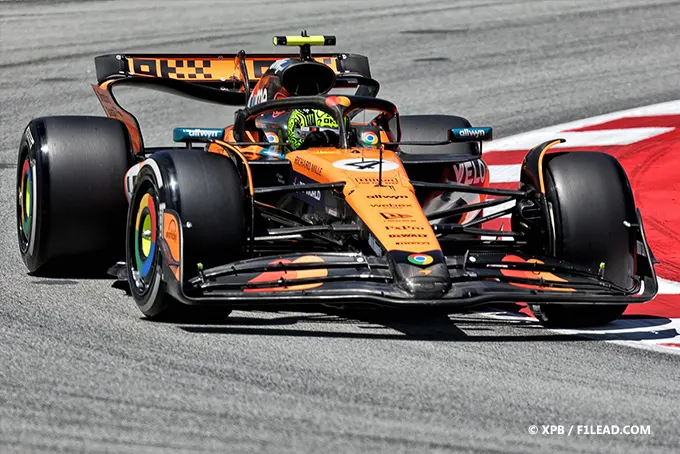Under scorching Spanish skies, Lando Norris sets the pace in FP1 as teams assess the impact of the new front wing rules.
The ninth race of the 2025 F1 season, the Spanish Grand Prix, begins under scorching sun. This weekend will unfold in intense heat, with track temperatures expected to easily exceed 50 degrees Celsius.
It’s also a crucial weekend for the season’s progression, as it marks the first application of the TD018 technical directive, which limits the flexibility of front wings on the cars, as announced late last year.
Christian Horner has been very vocal, saying it would change the course of the season, while Fred Vasseur simply stated that Ferrari was prepared for the change. Other teams have either remained discreet or expressed confidence, like McLaren, which has already run its reinforced wing.
FP1 Spain: A Full-Scale Technical Test Under Pressure
Extreme Heat and the TD018 Directive
The first free practice session in Barcelona was far from ordinary. With 50°C on the tarmac and the introduction of the TD018 directive limiting front wing flexibility, teams faced an entirely new context.
This regulatory shift, anticipated for months and feared by some like Red Bull, turned FP1 into a full-blown rolling laboratory.
Objective One: Understanding, Not Performance
This session was never about chasing lap times. The real goal was to gather as much aerodynamic data as possible.
With sensor grids, flow-vis paint and long runs, teams focused on assessing the on-track effect of their updated components, especially the modified front wings required or adapted in response to the new rule.
Every team except McLaren arrived with a batch of updates. Ferrari, Red Bull, Haas and Aston Martin brought new front wings.
Mercedes introduced a revised floor and rear wing. Williams updated its brake ducts and aero configuration.
Sauber added a front wing and engine cover. Racing Bulls also tweaked its nose. McLaren stood alone, bringing nothing new but appearing confident in its current package.
The pit lane moved away from a typical practice format into full diagnostic mode. The key question was clear: who could understand their car fastest under new constraints?
Pace Analysis: Lap Times Mean Little for Now
Lap times during this session told us little about real performance. Most drivers ran with high fuel loads and no intent to set benchmarks.
Even runs on soft tyres were more about assessing balance than reaching peak speed.
One emerging trend: the most mechanically stable cars had an advantage, especially early on, when tyre warm-up proved tricky on the baking hot track.
Others struggled with rigidity or unpredictable balance, as seen with Mercedes where Russell complained of a stiff front end.
Rookies and Young Drivers: Low-Key and Focused
Victor Martins for Williams and Ryo Hirakawa for Haas both made their official FP1 debuts.
Neither pushed the limits. Hirakawa had a brief moment in the gravel but recovered without damage. Martins kept things clean with installation laps and controlled outings.
Other young drivers like Bearman, Hadjar and Lawson also approached the session pragmatically.
Their job was clear: contribute data, avoid mistakes, and follow team instructions. None were expected to make headlines.
What FP1 Really Told Us
The teams are still in assessment mode. No one has revealed their full hand.
TD018 is being treated seriously: visible car updates, but incomplete understanding of its full impact.
The weekend will be defined by adaptation. The team that interprets its new package and the extreme heat fastest will gain the upper hand.
McLaren is on a different path. With no new parts and immediate pace, they may have either anticipated the directive well or are working from an inherently strong base.
This was not a showcase session. It was a test of reaction and understanding. Not a sprint, but a tactical warm-up. Reading too much into the lap times would be a mistake.
The true pecking order will emerge from how teams interpret and respond to this opening session.
Real answers will come in FP2 and especially in Saturday’s qualifying.
| Pos. | Driver | Team | Time | Laps |
|---|---|---|---|---|
| 01 | Lando Norris | McLaren Mercedes MCL39 | 1:13.718 | 29 |
| 02 | Max Verstappen | Red Bull Honda RBPT RB21 | 1:14.085 | 18 |
| 03 | Lewis Hamilton | Ferrari SF-25 | 1:14.096 | 29 |
| 04 | Charles Leclerc | Ferrari SF-25 | 1:14.238 | 31 |
| 05 | Oscar Piastri | McLaren Mercedes MCL39 | 1:14.294 | 28 |
| 06 | Liam Lawson | Racing Bulls Honda RBPT VCARB 02 | 1:14.339 | 28 |
| 07 | Oliver Bearman | Haas Ferrari VF-25 | 1:14.597 | 26 |
| 08 | Isack Hadjar | Racing Bulls Honda RBPT VCARB 02 | 1:14.605 | 26 |
| 09 | Yuki Tsunoda | Red Bull Honda RBPT RB21 | 1:14.643 | 27 |
| 10 | Pierre Gasly | Alpine Renault A525 | 1:14.746 | 28 |
| 11 | George Russell | Mercedes W16 | 1:14.751 | 32 |
| 12 | Lance Stroll | Aston Martin Mercedes AMR25 | 1:14.786 | 24 |
| 13 | Fernando Alonso | Aston Martin Mercedes AMR25 | 1:14.798 | 20 |
| 14 | Nico Hülkenberg | Stake F1 Kick Sauber C45 | 1:14.865 | 21 |
| 15 | Carlos Sainz | Williams Mercedes FW47 | 1:14.935 | 26 |
| 16 | Gabriel Bortoleto | Stake F1 Kick Sauber C45 | 1:15.155 | 23 |
| 17 | Ryo Hirakawa | Haas Ferrari VF-25 | 1:15.298 | 23 |
| 18 | Kimi Antonelli | Mercedes W16 | 1:15.369 | 31 |
| 19 | Victor Martins | Williams Mercedes FW47 | 1:15.522 | 26 |
| 20 | Franco Colapinto | Alpine Renault A525 | 1:15.530 | 19 |
- Discover More>Heat and McLaren Threat Loom for Ferrari in Spain
- Following us on>Facebook et Twitter
